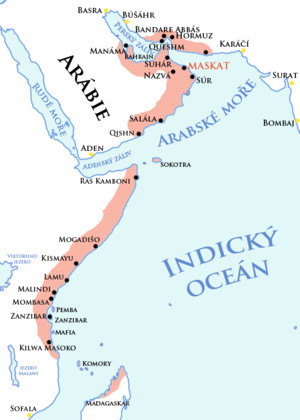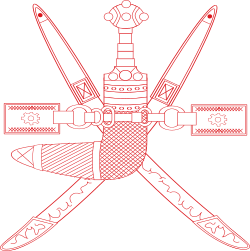Muscat and Oman
The Sultanate of Muscat and Oman (Arabic: سلطنة مسقط وعمان Salṭanat Masqaṭ wa-‘Umān) was a thalassocratic nation that encompassed the present-day Sultanate of Oman and parts of present-day United Arab Emirates and Gwadar, Pakistan. The country is not to be confused with the Trucial States, which were sheikhdoms under British protection since 1820. Muscat courts' verdicts were based on Ibadi Islamic sharia law and appeals were raised to the Sultan of Muscat, who exercised supreme ruling.[1]
Sultanate of Muscat and Oman سلطنة مسقط وعمان | |||||||||||||
|---|---|---|---|---|---|---|---|---|---|---|---|---|---|
| 1820–1970 | |||||||||||||
 | |||||||||||||
 The Sultanate of Muscat and Oman around the middle of the 19th century | |||||||||||||
| Status | Independent state (1820-1892) British Protectorate (1892–1971) | ||||||||||||
| Capital | Muscat | ||||||||||||
| Common languages | Omani Arabic, Persian, Ottoman Turkish, English | ||||||||||||
| Religion | Ibadi Islam | ||||||||||||
| Government | Absolute monarchy | ||||||||||||
| History | |||||||||||||
• General Maritime Treaty | 8 January 1820 | ||||||||||||
| 1856 | |||||||||||||
• Dhofar rebellion | 1962 | ||||||||||||
• Deposition of Said bin Taimur | 23 July 1970 | ||||||||||||
• Disestablished | 1970 | ||||||||||||
| Area | |||||||||||||
| 1965 est. | 212,000 km2 (82,000 sq mi) | ||||||||||||
| Population | |||||||||||||
• 1965 est. | 550,000 | ||||||||||||
| Currency | Indian rupee before 1959, Gulf rupee since 1959 | ||||||||||||
| |||||||||||||
| Today part of | |||||||||||||
Name
Strictly speaking, Oman (Imamate of Oman, Arabic: عُمان الوسطى, ʿUmān al-Wusṭā) is the inner, continental part of the region without access to the coast and with the capital in the city of Nizwa. Muscat is a coastal sultanate, the rulers of which, in fact, carried out expansion, including overseas[2]. Historical Muscat and Oman are separated by the Green Mountain plateau (Al Jabal Al Akhdar (Arabic: الجبل الأخضر))[3].
The third part of historical Oman (eastern Arabia) was the so-called "Pirate Coast", later known as Treaty Oman, and now - the United Arab Emirates (UAE). The fourth part of the historical and present Oman is Dhofar Governorate.
Also, one should not confuse the Oman Empire with the Ottoman empire.
Expansionist era
The expelling of the Portuguese colonizers happened during the Yaruba Imams era in the 17th century. The Yaruba Imams later succeeded in driving out the Portuguese colonizers from east Africa and established a maritime empire that extended its powers to the Persian Gulf and Zanzibar. The Yaruba dynasty later lost power to the Persian colonizers. In 1749, the Persian colonizers were defeated by the elected Imam Ahmad bin Said. The British empire was keen to dominate southeast Arabia to curb the influence of other European powers and to weaken the Omani Empire in the 18th century. The British empire thus backed the Albusaidi Sultans of Muscat that came to power in the second half of the 18th century. The British empire established a series of treaties with the Sultans with the objective of increasing British political and economic influence over Muscat. The Sultanate eventually became increasingly dependent on British loans and political advice.[4][5][6]
Historical differences always existed between the more secular, rich, seafaring coastal Sultanate of Muscat and the tribes of the interior. Though the inland territories were under nominal control of the Sultans of Muscat, they were in practice run by tribal leaders and the conservative Imams of Oman, practitioners of the Ibadi sect of Islam.

The Sultanate of Muscat possessed a powerful naval force, which enabled the creation of a maritime empire dating from the expulsion of the Portuguese in 1650 through the 19th century, at times encompassing modern Oman, the United Arab Emirates, southern Baluchistan, and Zanzibar and the adjacent coasts of Kenya, Tanzania and Mozambique. The Sultanate of Muscat also engaged in a very lucrative slave trade across east Africa.
Consolidation and decline

In the early 1820s, the Sultanate lost most of its territories in the Persian Gulf, which became the Trucial States under British protection. The fifth Sultan of the Al Said dynasty, Said bin Sultan, consolidated the Sultanate's territorial holdings and economic interests and Oman prospered. However, the Omani fleet was unable to compete with the more technically advanced European fleets and the Sultanate lost much of the trade with South Asia. Pressure by the British to abandon the slave trade further led to the loss of political and economic clout of the Sultanate.
On 4 June 1856, Said bin Sultan died without appointing an heir to the throne and members of the Al Said dynasty could not agree on a ruler. Through British mediation, two rulers were appointed from the Al Said clan; the third son of the Sultan, Thuwaini bin Said became ruler of the mainland. His sixth son, Majid bin Said, became ruler of an independent Sultanate of Zanzibar on 19 October 1856.[7] The Sultans of Zanzibar were thereafter obliged to pay an annual tribute to Muscat.[8]
The Imamate cause was renewed in the interior of Oman due to the development of British imperialism in the coastal Oman, the Sultanate of Muscat.[4] In 1913, a rebellion was led by Imam Salim Alkharusi against Muscat to reestablish an Imamate in the interior region of Oman.[4] The Imamate, similar to the Sultanate, was ruled by the Ibadi sect, however, the dispute between both parties was for the most part political.[9] The Omanis in the interior believed that the ruler should be elected and rejected British control over the Sultanate.[10][11] The Sultanate was however able to defend itself with British help. This historical split continued throughout much of the twentieth century with Sultan Taimur bin Feisal granting limited autonomy to the Imamate of Oman under the Ibadi clergy through the Treaty of Seeb in 1920.
The last overseas possession, the port of Gwadar across the Gulf of Oman, was sold to Pakistan in 1958. However, the sultanate did gain some territory in 1967, when Britain returned the Khuriya Muriya Islands (originally granted as a gift from the sultan to Queen Victoria in 1854).
Insurgency and oil drilling

The discovery of oil in the Persian Gulf exacerbated the dispute between the Sultan in Muscat and the Imams of Oman. Oil exploration had begun in the early 1920s by the Anglo-Persian Oil Company.[12] The course of the Second World War severely disrupted such activities. Further, the Sultanate of Muscat during that time was experiencing terrible social, economic and political conditions. The Sultunate was underdeveloped with no infrastructure or telephones, and Sultan Said bin Taimur prohibited anything that he considered "decadent", including radios.[10][11] The British government continued to have vast political control over the Sultanate as the chief adviser to the Sultan, defense secretary and all ministers of the Sultanate except for one were British.[10] The British government, Iraq Petroleum Company and the Sultan were keen to search for oil and made early plans (1946) to establish an army that could occupy the Imamate of Oman.[13][14]
The last Imam of Oman, Ghalib Bin Ali, started an uprising in 1954 when the Sultan granted licenses to the Iraq Petroleum Company despite the fact that the largest oil fields lay inside the Imamate. The hostilities were put down in 1955, but the longer conflict would evolve into the Jebel Akhdar rebellion, where Sultan Said bin Taimur relied heavily on continued British military support. Iraq Petroleum, along with its operator of oil exploration, Petroleum Development Oman, was owned by European oil giants including Anglo-Iranian Oil's successor British Petroleum which encouraged the British government to extend their support to the Sultan.
The insurgency erupted again in 1957, when Saudi Arabia began supporting the Omani rebels, but eventually the Sultan was able to establish pre-eminence over most of the inland. The same year, British forces bombarded the town of Nizwa, the capital of the Imamate, and toppled the Ibadi theocracy. Ghalib Bin Ali went into exile in Saudi Arabia and the last rebel forces were defeated two years later, in 1959. The Treaty of Seeb was terminated and the autonomous Imamate of Oman abolished.[15]
The frequency of uprisings such as the Dhofar Rebellion, supported by the communist government of South Yemen,[16] motivated the British to supplant the Sultan. The British chose the Western-educated son of the Sultan, Qaboos bin Said who was locked up in the palace, because his paranoid father feared a coup. On his release, Qaboos bin Said, with the help of British military forces, staged a successful palace coup and was proclaimed Sultan of Muscat and Oman in 1970. The newly consolidated territories along with Muscat were reorganized into the present-day unified Sultanate of Oman by August 1970.[17]
In 1976, again with British aid, the Sultan secured his hold over the entire interior and suppressed the Dhofar rebellion.
Sohar Sultanate
The Sohar Sultanate lasted from 1920 until about 1932. In 1920, Sheik Ali Banu Bu Ali, a relative of Sultan Taimur bin Faisal, rebelled in the northern town of Sohar and proclaimed himself Sultan but was deposed by the British in 1932.
See also
References
- "Historical Summary of Events in the Persian Gulf Shaikhdoms and the Sultanate of Muscat and Oman, 1928-1953' [96r] (196/222)". QDL.
- A history of Muscat and Oman Archived 1 July 2013 at the Wayback Machine
- The Western Hajar Mountains
- The Oman Question: The Background to the Political Geography of South-East Arabia J. C. Wilkinson.
- "The Rough Guide to Oman". Penguin. 1 November 2011. ISBN 978-1-4053-8935-8. Retrieved 11 November 2013.
- "Background Note: A Close Relationship: Britain and Oman Since 1750". QDL.
- Ingrams 1967, pp. 163–164
- "Background Note: Oman". U.S Department of State – Diplomacy in Action.
- CNN Arabic: وفاة آخر أئمة عُمان في منفاه السياسي بالسعودية
- The Guardian: Britain’s secret wars
- British National Archive: Muscat and Oman Internal Affairs History
- "Overview". Omani Ministry of Information. Archived from the original on 1 October 2011.
- The Foreign Office London: File 8/62 Muscat State Affairs: Principal Shaikhs and Tribes of Oman [146r] (291/296).
- Peterson, J. E. (2 January 2013). "Oman's Insurgencies: The Sultanate's Struggle for Supremacy". Saqi. Retrieved 29 April 2018 – via Google Books.
- "Background Note: Oman". U.S Department of State – Diplomacy in Action.
- "Background Note: Oman". U.S Department of State – Diplomacy in Action.
- "Tribute to His Majesty". Omani Ministry of Information. Archived from the original on 18 January 2006.

